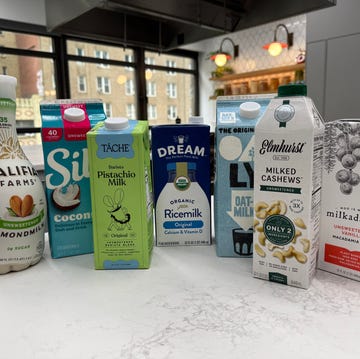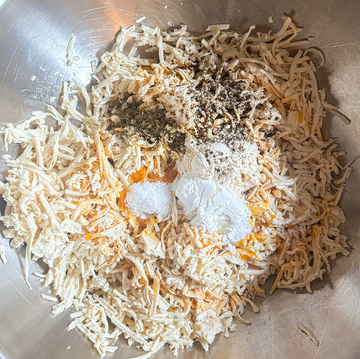Step aside, rainbow and pignoli cookies—cannoli are the real star of any Italian bakery. I spent nearly four years living in the heart of New York City's Little Italy, so you can guess that I've eaten my fair share from my neighborhood spots. The snap of the fried pastry, the creamy, decadent filling, and the generous dusting of powdered sugar all work together to form a near perfect dessert.
You may think of the large, abundantly filled pastries as an Italian American staple. But you may not know that the origin story of cannoli (which is the plural version of cannolo, BTW) dates back centuries in the island of Sicily. I had the privilege of traveling with Imago Artis to Palermo, the island's capital and the birthplace of cannoli.
After eating my way through the island, I caught up with the chefs at the historic Villa Igiea (which appeared in an episode of The White Lotus season two!) to talk all things cannoli. Not only did they reveal their fan favorite recipe, but they also unpacked the history of the beloved dessert.
And that history, which spans nearly 1200 years, comes with its fair share of stories. The cannoli origin story might not be what you expect—that's why we've rounded up some of the most interesting facts about real Sicilian cannoli that might just change how you see this iconic dessert.
Cannoli Shouldn't Be That Sweet
Italian-American renditions of cannoli are often pretty sweet, even without the mountain of powdered sugar sprinkled over the top. But when you go back to the motherland, the crispy fried pastry has a lot more nuance. At Villa Igiea, their dough uses less than half a cup of sugar, which lets the other flavors shine. The Sicilian recipe blends cinnamon, coffee, and cocoa for added layers of depth. Instead of a golden shade like American versions, Italian cannoli pastry takes on a dark, toasty brown hue.
But the definitive star of an authentic cannoli dough is the Marsala wine. This sweet, fortified wine from Sicily imparts another layer of mild sweetness similar to what you'd get from dried fruit. Combined with the lightly sweet ricotta-based filling, a bite of an authentic cannolo is a far cry from some cloyingly sweet versions you can find in the States.
Yes, They're Meant To Look Like That
If you've ever associated cannoli's signature shape with a certain body part, you're not delusional. In fact, the history of the dessert is inherently rooted in sexuality. It's believed that the cannoli we know and love were invented by a prince's harem in ninth-century Sicily in honor of his...you know.
Another theory takes place a few hundred years later. The desserts were made as a symbol of fertility for religious events in a newly Catholicized Sicily. National Geographic reports that "the making and consumption of suggestive foods was associated with celebrating fertility and helped foster a connection with the divine."
Cannoli's cultural impact stayed suggestive long after their invention. They became a fixture of the pre-Lenten holiday Carnevale. As with Carnival celebrations across modern-day Latin America and the Caribbean, Sicilian Carnevale was full of dancing and food. You could find street vendors selling cannoli to revelers, who often gifed them to prospective lovers alongside lyrics that use the dessert as a flirtatious euphemism.
The Ingredients Have Eclectic Roots
Cannoli are arguably the most famous dessert to come out of Sicily—and that island has had many cultural influences. Its strategic location in the heart of the Mediterranean Sea made it a lucrative territory for empires throughout history. The legend surrounding that harem of women dates back to Arab rule in the ninth century, which brought both coffee and cinnamon to the region.
Sicily's robust wine history, including that of Marsala, can be attributed to ancient Greek influence. The use of cocoa comes from the Americas by way of the Spanish occupation of Sicily in the 16th century. Nearly every ingredient that goes into the cannoli—at Villa Igiea and everywhere else on the island— has a unique origin story that reflects Sicily's own history.
Nuns Made Cannoli Popular
Many culinary specialties across Europe can be attributed to the work of the clergy. Herbal liqueurs are often medicinal inventions made by priests using local botanicals. Even today, the recipe for the French liqueur Chartreuse is guarded by only two Carthusian monks at any given time.
For a large portion of the middle ages, cannoli were kept alive by nuns across Sicily. Pastry-making was commonplace in monasteries, originally to serve noble guests. As agricultural technology expanded and made ingredients more affordable, selling cannoli and other desserts became a large-scale operation.
At their peak in the 18th century, it's believed that there were as many as 21 convents making pastries in the capital city of Palermo. Only a few are still up and running today, but you can still find fresh cannoli in virtually every corner of Sicily. They won't taste quite like the American versions you're used to, but the original Sicilian version is equally, if not more delicious.
















